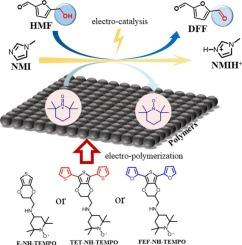Preparation of EDOT-based TEMPO polymers and the electrocatalytic performance for HMF oxidation
IF 6.3
2区 化学
Q1 POLYMER SCIENCE
引用次数: 0
Abstract
In this study, three novel EDOT-based TEMPO derivative monomers 4-(((2,3-dihydrothieno[3,4-b][1,4]dioxin-2-yl)methyl)amino)-2,2,6,6-tetramethylpiperidin-1-yloxy (E-NH-TEMPO), 4-(((5,7-di(thiophen-2-yl)-2,3-dihydrothieno[3,4-b][1,4]dioxin-2-yl)methyl)amino)-2,2,6,6-tetramethylpiperidin-1-yloxy (TET-NH-TEMPO) and 4-(((5,7-di(furan-2-yl)-2,3-dihydrothieno[3,4-b][1,4]dioxin-2-yl)methyl)amino)-2,2,6,6-tetramethylpiperidin-1-yloxy (FEF-NH-TEMPO) were successfully synthesized. The corresponding polymer electrodes (PE-NH-TEMPO, PTET-NH-TEMPO and PFEF-NH-TEMPO) were prepared via electrochemical polymerization. Compared with E-NH-TEMPO, attaching thiophene rings to α-positions of EDOT helped to improve the polymerization performance of TET-NH-TEMPO, whereas the presence of furan rings impaired the polymerization performance of FEF-NH-TEMPO. Meanwhile, PTET-NH-TEMPO showed high electrocatalytic activity for selective oxidation of HMF with the presence of N-methylimidazole in the solution. In addition, the oxidation reaction of HMF on PTET-NH-TEMPO was monitored using in situ FTIR technology, and the possible mechanism was proposed.

edot基TEMPO聚合物的制备及其对HMF氧化的电催化性能
本研究成功合成了3个新的edot基TEMPO衍生单体4-((2,3-二氢噻吩[3,4-b][1,4]二恶英-2-基)甲基)氨基)-2,2,6,6-四甲基胡椒-1-基氧基(E-NH-TEMPO)、4-((5,7-二(噻吩-2-基)-2,3-二氢噻吩[3,4-b][1,4]二恶英-2-基)甲基)氨基)-2,2,6,6-四甲基胡椒-1-基氧基(TET-NH-TEMPO)和4-((5,7-二(呋喃-2-基)-2,3-二氢噻吩[3,4-b][1,4]二恶英-2-基)甲基)氨基)-2,2,6,6-四甲基胡椒-1-基氧基(FEF-NH-TEMPO)。通过电化学聚合法制备了相应的聚合物电极PE-NH-TEMPO、PTET-NH-TEMPO和PFEF-NH-TEMPO。与E-NH-TEMPO相比,噻吩环在EDOT的α-位置上有利于提高TET-NH-TEMPO的聚合性能,而呋喃环的存在则会降低FEF-NH-TEMPO的聚合性能。同时,在n -甲基咪唑存在的情况下,PTET-NH-TEMPO对HMF的选择性氧化表现出较高的电催化活性。此外,利用原位FTIR技术对HMF在PTET-NH-TEMPO上的氧化反应进行了监测,并提出了可能的氧化机理。
本文章由计算机程序翻译,如有差异,请以英文原文为准。
求助全文
约1分钟内获得全文
求助全文
来源期刊

European Polymer Journal
化学-高分子科学
CiteScore
9.90
自引率
10.00%
发文量
691
审稿时长
23 days
期刊介绍:
European Polymer Journal is dedicated to publishing work on fundamental and applied polymer chemistry and macromolecular materials. The journal covers all aspects of polymer synthesis, including polymerization mechanisms and chemical functional transformations, with a focus on novel polymers and the relationships between molecular structure and polymer properties. In addition, we welcome submissions on bio-based or renewable polymers, stimuli-responsive systems and polymer bio-hybrids. European Polymer Journal also publishes research on the biomedical application of polymers, including drug delivery and regenerative medicine. The main scope is covered but not limited to the following core research areas:
Polymer synthesis and functionalization
• Novel synthetic routes for polymerization, functional modification, controlled/living polymerization and precision polymers.
Stimuli-responsive polymers
• Including shape memory and self-healing polymers.
Supramolecular polymers and self-assembly
• Molecular recognition and higher order polymer structures.
Renewable and sustainable polymers
• Bio-based, biodegradable and anti-microbial polymers and polymeric bio-nanocomposites.
Polymers at interfaces and surfaces
• Chemistry and engineering of surfaces with biological relevance, including patterning, antifouling polymers and polymers for membrane applications.
Biomedical applications and nanomedicine
• Polymers for regenerative medicine, drug delivery molecular release and gene therapy
The scope of European Polymer Journal no longer includes Polymer Physics.
 求助内容:
求助内容: 应助结果提醒方式:
应助结果提醒方式:


